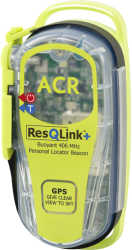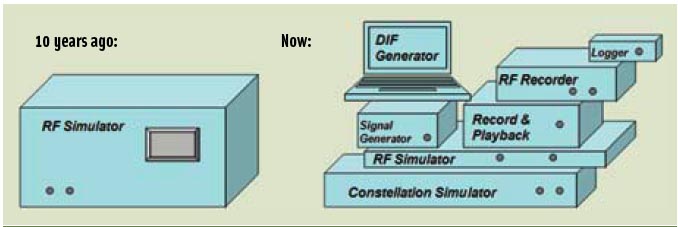 ACR’s ResQLink+ Buoyant Personal Locator Beacon.
ACR’s ResQLink+ Buoyant Personal Locator Beacon.Spirent Communications plc this week announced its test solutions have been used to improve maritime safety, and this development came about after much collaborative work designed to ensure that GNSS receivers are performing as needed, especially for rescue operations at sea.
Working with the Radio Technical Committee for Maritime Services (RTCM), Spirent has created test scenarios that simulate realistic satellite reception conditions at sea so that GPS distress beacon performance can be improved, allowing users to be rescued faster by search and rescue organizations.
Spirent Communications plc this week announced its test solutions have been used to improve maritime safety, and this development came about after much collaborative work designed to ensure that GNSS receivers are performing as needed, especially for rescue operations at sea.
Working with the Radio Technical Committee for Maritime Services (RTCM), Spirent has created test scenarios that simulate realistic satellite reception conditions at sea so that GPS distress beacon performance can be improved, allowing users to be rescued faster by search and rescue organizations.
One of the first customers to use these scenarios to test its locator beacons is ACR Electronics, Inc., a leading manufacturer of emergency lifesaving equipment. Its latest ACR and ARTEX products have been tested using a Spirent signal simulator, and have been certified as meeting the RTCM standards for cold-start time-to-first-fix, which specifies the time taken by a device when it is turned on to capture GPS signals and determine its location.
“We were asked to develop some test scenarios along with RTCM that could be used as part of the testing of EPIRBs and PLBs so in conjunction with RTCM we worked on a set of scenarios that we felt would be a good test of the GNSS systems,” explained Steve Hickling, marketing lead military, government, space and GNSS systems at Spirent in West Sussex, United Kingdom.
In the United States the Federal Communications Commission (FCC) has now mandated that in the future, any new products in the related categories must be tested using a GNSS simulator and the scenarios in the RTCM standards, which were developed by Spirent.
Bill Cox, director of engineering at ACR, said: “We are able to test the performance of our dual-frequency GPS/Galileo receivers using a Spirent simulator that can accurately simulate signals from different constellations to enhance the performance of our Emergency Position Indicating Radio beacons (EPIRBs, PLBs and ELTs). Our customers will soon be able to take advantage of a new confirmation system that will let them know that their call for help was heard.”
“We are very pleased to have worked with RTCM and ACR to improve maritime safety”, said Martin Foulger, general manager of Spirent’s Positioning Business Unit. “This project shows the importance of testing in realistic conditions to give better end-user experience, which in this case could be a matter of life or death. This will make lifesaving equipment more reliable both for maritime users and search and rescue agencies.”
Hickling added that it’s critical to make sure equipment — especially that being used for search and rescue — is meeting some type of standard to ensure reliability.
“The intent really is to make sure that they’re fit for the purposes, to try and make sure the receivers being used in these pieces of equipment deliver when they need to,” Hickling said. “One of the things that’s intriguing about GNSS is that no receivers are the same…it isn’t a sort of plug-and-play environment. Receivers are designed to do different jobs.”
Because of this, he said, these tests became necessary. End users need to make sure that a receiver that is selected by a manufacturer is fit for the purpose, so these tests really center around the kinds of environments that you would see in a rescue situation.
The RCTM discovered that Cospas-Sarsat 406MHz beacons with integral GPS receivers suffered from poor cold start performance, causing delays in providing accurate location information to Search and Rescue (SAR) authorities. It later discovered that this was because beacons tended to be tested on land in benign conditions, rather than in real-world oceanic conditions.
It has addressed the issue by specifying a set of performance standards for Emergency Position Indicating Beacons (EPIRBs), Personal Locator Beacons (PLBs), Hand-held VHF Radios with integral GPS Receivers, Manoverboard (MOB) devices and Satellite Emergency Notification Devices (SENDs).
Spirent was asked to develop a set of custom test scenarios that enable manufacturers to simulate realistic satellite reception conditions at sea in laboratory environments. Use of these scenarios enables manufacturers to better assess the performance of their products in the real world.
This project is another example of Spirent listening to the needs of its customers, according to Hickling.
“We’ve always recognized that having a test instrument is a great start but it isn’t the answer to anyone’s problem,” Hickling said. “So, we have offered a test method development in the past and we’re now making that much more an up-front part of our offer as well as offering instruments. We will develop with users test scenarios, test cases and indeed if asked to do so we’ll do testing ourselves.
“This specific one is a great, high-profile example of working collaboratively with our users to make sure that they don’t just get a kit but a solution.”
He added that in this case, the result is a solution that RCTM can promote to anybody that wants to test to this new standard, and to be confident that it will address everything if they use these scenarios.
For more information on Spirent’s GNSS testing solutions, visit their website,
or to learn more about how to test receivers of GPS, Galileo and other
GNSS, download the company’s latest eBook.
Details of the FCC mandate can be found in the Federal Register Vol 81 No 241 Dec 15, 2016 Page 90739 FCC 47 CFR Parts 1, 25, 80 and 95.





